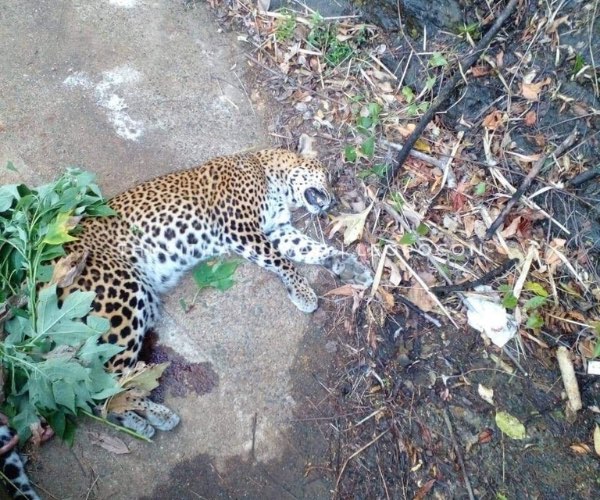
Jul 12 2022.
views 479A recent road kill took the life of a leopard in Ududumbara. Conservationists believe this to be a first in the area, showing signs of potential threats to leopards and other wildlife populations in the area. The ever-expanding road network has made wildlife more vulnerable to road kills and increasing this risk further, roads are now being constructed via buffer zones and protected areas as well. Organisations such as Leopocon are devoted to conserving leopards and their ecosystems and place a heavy emphasis on the concept of citizen science. Speaking to the Daily Mirror Life, Executive Director of Leopocon, Sethil Muhandiram explained the reasons for the spike in road kills, preventive measures that could be taken, and the importance of citizen science.

Pictured: Sethil Muhandiram
A spike in road kills
An increase in road kills has been observed between 2020 and 2021 during the post-pandemic period. “It is believed that the number of wild animals, birds, and serpents is declining largely due to poaching going on indiscriminately in our forests,” opined Muhandiram. “But shrinking habitats of wild animals due to large-scale encroachments and disturbances in wilderness areas cause such incidents to spike more than usual. Wild animals move through landscapes to find water, food, shelter, mates, and nesting sites, but roads and traffic make it more difficult and dangerous for them. Between 2020-2021, especially after post-pandemic time, we observed a rise in road kills because during pandemic times travel restrictions were in place and wild animals changed their behaviours and came out to roam freely. But unfortunately, when the restrictions were lifted wild animals were killed by many roadside accidents, this mainly impacted small mammals and reptiles that tried to cross roads as usual during pandemic times. Considering our country, especially in dry zone areas mortality in wildlife due to transportation is in higher numbers.”
Preventive measures
However several preventive measures could be introduced to ensure that the leopards and vulnerable animals are being protected. For this, Muhandiram suggests speed limits as one way of controlling road kills. “But it cannot be applied to expressways sometimes. On the other hand, it’s difficult to put a speed limit to an early-developed road. It’s easier to plan a new road, perhaps put it in a better location or build bridges or wildlife crossings or over / underpasses, from the start. That’s why we need thorough assessments to prevent such incidents from happening. When it comes to nature reserves and protected areas that were exposed by roads, we can put out speed breakers to control the speed. Countries like the Netherlands installed fences to keep animals off the road and guided them to the overpass which they built for animals to cross sides. We can put up signs to warn motorists of the possibility of wildlife on the road, especially in areas where animals frequently move around. We also can provide measures like Canopy crossings and can implement methods like an Escape route to prevent road kills.”
Technological interventions
Technology can play a big role in this situation. “But we need to identify areas of road kills based on species type, areas with nature reserves and such,” Muhandiram explained further. “Based on the identification of roadkill hot spots and cold spots, we can implement real-time image processing systems like CCTV to monitor such wildlife corridors or hotspots to avoid them from getting hit by vehicles. We can use drones to monitor behaviours of the drivers and local authorities can use speed monitors to observe the speed limits of drivers as well. Many road kills happen during nighttime, and we need to observe wildlife crossings including the times they are active, species that crossroads, and other concerning factors. We can use infrared systems and can install trail cameras to gather information related to wildlife so that we can plan out ways to keep both wildlife and drivers from such scenarios. Roadkill observation projects should be launched in identified areas.”

Road kills in Central Highlands
The recent leopard death in Ududumbara that happened as a result of a road kill is a first in the area. “But when it comes to Central Highlands there are a few incidents that killed leopards and other feline species due to roadside accidents. The development of roads affects wildlife by altering and isolating habitats and populations, deterring the movement of wildlife, and resulting in extensive wildlife mortality. Expanding plantations in Central Highlands, especially in areas like Ududumbara where there are several interconnected forest reserves and protected areas will affect wildlife to flee from their current habitats and find new ones. Even man-made disturbances like deforestation, wildfires, and habitat encroachments lead animals to find secure environments for them to survive. On the other hand, the lack of food types, and lack of prey abundance especially for felines drive them away from their territories. Leopards are highly solitary animals and they live on considerable territory. When there’s a disturbance in their territory they shift from one place to another and sometimes these territories overlap with human settlements.
Sometimes leopards do roam within human settlements to get easy prey types like dogs and livestock. Also, like elephants, leopards too have corridors. They use these paths to find food and even to find partners. We believe the leopard that got killed is not a stranger to the area but a frequent visitor. Because there were several sightings that were reported before the incident and maybe this must be the same animal that residents have witnessed. It may have been seeking a potential area to get settled or sometimes it was seeking prey. We need to carry out extensive investigations to reduce further incidents from happening and we are already in talks with local authorities and with residents to gather more information related to the presence of big cats within the area.”
The need to bridge development and biodiversity
More roads are now being constructed via buffer zones posing heavy threats to wildlife and their existence. “Widespread attention continues to be drawn to the ecological effects of roads, especially as the road system continues to expand. Before all these developments we need to understand the appropriate spatial scales for different ecological processes that might be affected by roads. The effects of road density on ecosystem structures and functioning and on the provision of ecosystem goods and services need to be studied. We also need to educate communities about the importance of wildlife and biodiversity around them before such project launches. As a conservationist, I believe that we need to collaborate with local authorities to discuss possible impacts on the environment while educating the general public on sustainable development. We should not put sustainable development just as a term but in a more practical way to be supportive towards the environment and communities around which can then build coexistence between development and biodiversity.”
How citizen science helps the environment
“Leopocon is based on citizen science,” he added. This means practically all the data gathering, research and advocacy happen involving the general public. Citizen science uses the collective strength of communities and the public to identify research questions, collect and analyze data, interpret results, make new discoveries and develop technologies and applications. By gathering all data that we need we create small pocket plans to mitigate conflicts and misunderstandings between wildlife and communities. Physical and virtual awareness is one of the major concepts to spread awareness on issues related to wildlife. We use several resource persons including Department of Wildlife officials, and forest department officials to raise awareness in the area, especially about biodiversity and its importance.
We take school students, community leaders, and young groups onboard to carry out awareness while educating them about animal behaviours while gathering information related to environmental changes that they witness within their community. These programmes help us to initiate community action programmes to safeguard leopards and other wildlife in the area by mitigating conflicts and creating safer environments for both parties. Using citizen science methods team Leopocon has engaged in raising environmental literacy within communities, especially in identified areas in the country.”
A conservationist’s advice to society
Muhandiram believes that people should be responsible. “Be watchful in areas near woods and water. Be mindful when driving because wildlife does cross from one side to the other when there’s a forest complex nearby. Take special care near animal crossings, warning signs, or signs warning of the absence of fences. The signs are there for a reason. Slowing down a little gives you and the animal more time to react. Be especially cautious at night. Always consider if the land along the road could host large animals and if you think it could, anticipate that they might run out into the road. There were several road kills reported over years resulting in leopard deaths. Always try to avoid such situations by being vigilant,” he said in his concluding remarks.
0 Comments